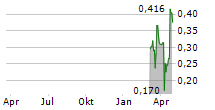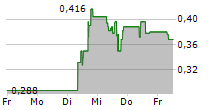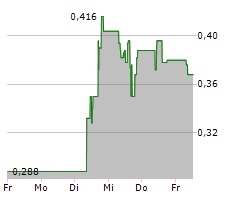Vancouver, British Columbia--(Newsfile Corp. - August 6, 2025) - West Point Gold Corp. (TSXV: WPG) (OTCQB: WPGCF) (FSE: LRA0) ("West Point Gold" or the "Company") is pleased to announce results from its initial reverse circulation drill program at the Frisco Graben target in the Company's Gold Chain Project, Arizona. This release summarizes the results from Holes GC25-53 through -56, a total of 1,092.7 metres, and integrates the results with geophysical, geochemical and hyperspectral studies. Exploration to date supports West Point Gold's belief that the Frisco Graben is highly prospective for concealed gold mineralization related to the intersection of the northeast extension of the Tyro structural corridor and the NW-trending Frisco Mine fault.
Highlights:
- The initial four holes, ranging in length from 232 to 329m, encountered anomalous gold values (up to 0.081 g/t Au) immediately below the Frisco Mine fault.
- The rocks drilled within the Frisco Graben are deeply oxidized and altered (kaolinite-silica-hematite) and continue to highlight the potential for gold mineralization at depth.
- Mercury, a traditional indicator metal for gold in low-sulphidation epithermal systems, was encountered for the first time in meaningful quantities at Gold Chain.
- Hyperspectral and geochemical analyses of the drill cuttings suggest that drilling remained in the 'steam-altered' environment up to the Frisco Mine fault above the desired elevation. Follow-up drilling will target the Tyro intersection deeper in the system.
- The suspected 'boiling zone', which likely encompasses the nearby veins of the Main Tyro zone and evidently along the extended structure, remains untested at depth at the Frisco Graben.
"Initial drilling at the Frisco Graben continues to suggest that there is potential for a large-scale gold system at depth, particularly given that anomalous gold was encountered in the alteration zone, above where one would expect to find gold mineralization. The Company plans to follow up with deeper drilling, guided by these results, historical drilling and ongoing studies", stated Quentin Mai, CEO, "The Frisco Graben remains a compelling target that warrants follow-up drilling."
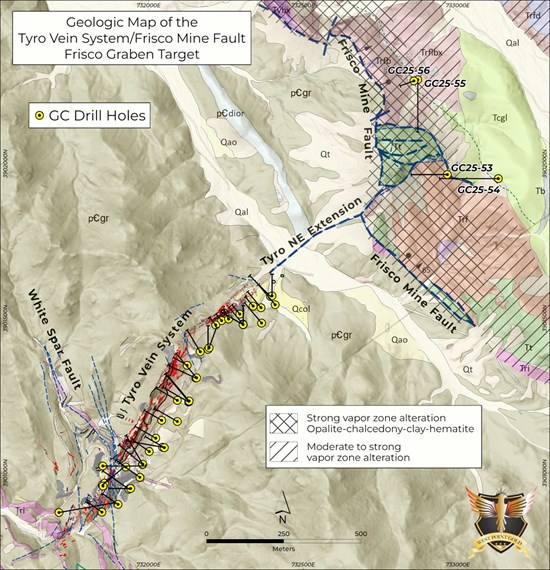
Figure 1: Geologic map of the Main Tyro vein and intersection with the Frisco Mine fault showing geology, alteration and drill holes.
To view an enhanced version of this graphic, please visit:
https://images.newsfilecorp.com/files/5717/261420_28770caec4f3b94a_002full.jpg
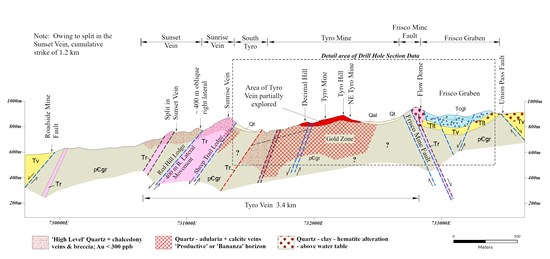
Figure 2: Schematic Long Section of the Tyro Vein System extending across the Gold Chain project. Inset box defines area of the Tyro Main vein and the Frisco Graben (see Figures 3, 4 & 7).
To view an enhanced version of this graphic, please visit:
https://images.newsfilecorp.com/files/5717/261420_28770caec4f3b94a_003full.jpg
Drill Results Summary
Four RC holes were completed across the intensely altered volcanic and sub-volcanic rocks in the HW of the Frisco Mine fault near its intersection with the Tyro fault/vein complex (Figure 1). A primary goal of this drilling was to determine the presence of gold mineralization in the permeable volcanic tuffs and breccia beneath below the 'steam altered' rocks. Geochemical and subsequent hyperspectral studies suggest that drilling exited the graben at the Frisco Mine fault and above the desired location and/or elevation, i.e. the base of the clay-rich alteration or the intersection with the Tyro fault/vein. Consequently, the 'boiling zone' at the intersection remains untested. Important gold anomalies were encountered up to 0.081 ppm Au in the Precambrian rocks in the footwall of the Frisco Mine fault (Figure 3) and outside of the 'steam altered' environment.
Drilling in 2025 along the Main and NE Tyro Vein segments (Figure 1) has better defined a structural corridor hosting a broad, steeply dipping zone of gold-bearing veins, veinlets and breccia up to 200m below the surface. Drilling across the Northeast Zone has revealed a greater proportion of chalcedony-calcite-adularia veins with higher gold grades including GC25-47 (50.29m at 3.76 g/t Au).
Continued drilling to the northeast, i.e. Holes GC25-45, -46, -57, -58 and -59, suggest the mineralization is plunging toward the Frisco Mine fault (Figure 3).
Holes GC25-53 through -56 (Figure 1), drilled across the altered volcanic rocks of the Frisco Graben, have defined a hydrothermal environment distinct from the one defined along the Main Tyro zone shown in Figure 2. This distinction is best explained by a component of post-mineral faulting not observed along the Tyro vein system nor the Frisco Mine fault (Figure 1).
Holes GC25-53 through -56 have traversed a thick succession of high-level, kaolinite-opaline silica-hematite alteration of a dissected felsic flow dome complex in the HW of the Frisco Mine fault (Figure 2). Gold is locally, but weakly, anomalous in immediate proximity to the Frisco Mine fault (Figure 3). The pervasively kaolinite-silica-hematite altered volcanic package in the HW of the fault (Figure 4) contains elevated mercury (Figure 7) associated with silicification and minor quartz veinlets. These anomalies appear to be associated with several sub-vertical breccia bodies of likely hydrothermal origin. The floor of this volcanic package is the Frisco Mine fault below which the Precambrian rocks dominate (host to the Tyro Vein system). Consideration of the integrated results of magnetometry, radiometrics, hyperspectal studies and geochemistry, indicate that deeper drilling must be conducted to explore beneath the barren "lithocap".
Next Steps
The 2025 results support following the Frisco Mine fault to greater depths and below the vapor dominated environment. The area currently permitted for drilling will need to be expanded to the south (K anomaly + mag low; Figure 6) and east (below the kaolinite environment) prior to drilling.

Figure 3: Longitudinal perspective, showing gold values in drill holes, of the Main Tyro vein system relative to 2025 drilling in the adjacent Frisco Graben. The geologic environment hosting gold mineralization at Tyro likely underpins the steam altered environment of the Frisco Graben in the hanging wall of the Frisco Mine fault.
To view an enhanced version of this graphic, please visit:
https://images.newsfilecorp.com/files/5717/261420_28770caec4f3b94a_004full.jpg
Hyperspectral Survey
Hyperspectral imaging utilizes the VNIR - SWIR (0.4-2.5 µm) wavelength ranges which provide information to detect the mineralogical composition of outcropping lithological (outcrop, core and cuttings) units. Alteration minerals in the SWIR region can be spectrally characterized owing to features related to Al-OH, Fe-OH, and Mg-OH. Al-OH (e.g., phyllosilicate minerals such as clays and micas) and Mg-Fe-OH/CO32- (e.g., carbonate, chlorite, and epidote) alteration minerals associated with gold mineralization can be detected using hyperspectral imaging sensors' SWIR bands.
Analyses were conducted at the Colorado School of Mines through West Point Gold's membership in the Center to Advance the Science of Exploration to Reclamation in Mining ("CASERM"). Reverse Circulation drill cuttings from Holes GC25-53 to -56 were analyzed and kaolinite was chosen to represent the Frisco Graben subsurface owing to its common presence high in gold systems caused by the percolation of acidic steam above the boiling zone. Figure 4 clearly shows that the volcanic sequence drilled is replaced by kaolinite down to the graben's southwest margin, the Frisco Mine fault.

Figure 4: Longitudinal perspective of the Frisco Graben 2025 drill holes showing kaolinite as the dominant alteration product defined by hyperspectral analyses relative to the Main Tyro vein system where kaolinite is rarely observed.
To view an enhanced version of this graphic, please visit:
https://images.newsfilecorp.com/files/5717/261420_28770caec4f3b94a_005full.jpg
Airmag Survey
West Point Gold conducted a heli-borne triaxial gradio-magnetics survey over the Gold Chain project in 2022. A portion of the survey is presented in Figure 5 showing Residual Magnetic Intensity/Reduced to Pole over the Main Tyro vein system, the Frisco Mine fault and a portion of the Frisco Graben. In general terms, epithermal mineral deposits are spatially coincident with magnetic lows (cool colors) owing to the destruction of magnetite by mineralizing fluids. Magnetic lows may also reflect rhyolite dikes which is clearly reflected by the White Spar fault in Figure 5 (lower left) which hosts a dike complex. Most importantly, the Tyro vein system follows an irregular mag low which penetrates the Frisco Mine fault and occupies a quadrant at the structural intersection.

Figure 5: Residual Magnetic Intensity/Reduced to Pole over the Main Tyro vein system, the Frisco Mine fault and a portion of the Frisco Graben. The results reveal magnetite destruction coincident with defined gold mineralization and/or rhyolite intrusives and useful in defining targets.
To view an enhanced version of this graphic, please visit:
https://images.newsfilecorp.com/files/5717/261420_28770caec4f3b94a_006full.jpg
Radiometric Survey
A radiometric survey (K-U-Th) was conducted over the Gold Chain project in conjunction with the high-resolution aeromagnetic survey in 2022. More specifically, potassium (K) was chosen to highlight an anomaly in the HW of the Tyro and Frisco Mine faults at their intersection a few hundred metres northeast of the Tyro mine (Figure 6). The anomaly closely correlates with a strongly altered, sub-volcanic felsic body. The anomaly may reflect high potassium related to an intrusive or K in adularia- or illite-bearing rocks.
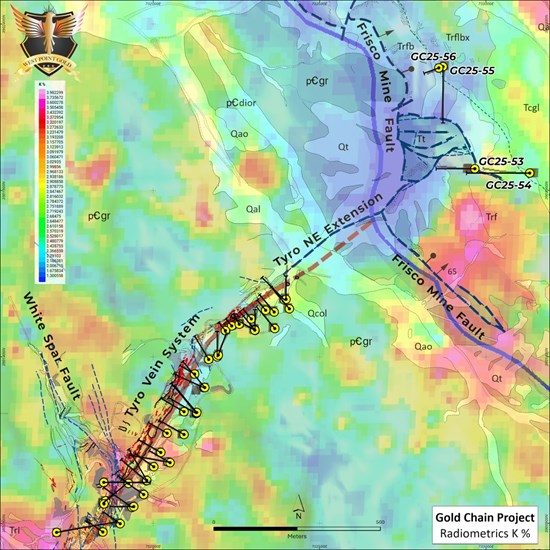
Figure 6: Potassium (K) enrichment in the hanging wall of the Frisco Mine fault may reflect adularia above a concealed deposit or a K-rich intrusive phase.
To view an enhanced version of this graphic, please visit:
https://images.newsfilecorp.com/files/5717/261420_28770caec4f3b94a_007full.jpg
Mercury (Hg) Geochemistry
Mercury (Hg) analyses of the drill samples for all Tyro and Frisco holes are plotted below (Figure 7). Emphasis is placed on relatively high Hg values in the Frisco Graben (steam heated) environment relative to Tyro Vein system (boiling zone). Globally, numerous examples exist in defined/known epithermal districts where Hg is partitioned into the vapor phase of gold-related hydrothermal events.

Figure 7. Longitudinal view of the Main Tyro vein system -Frisco Graben area revealing relatively high mercury in the volcanic complex situated in the HW of the Frisco Mine.
To view an enhanced version of this graphic, please visit:
https://images.newsfilecorp.com/files/5717/261420_28770caec4f3b94a_008full.jpg
Qualified Person
Robert Johansing, M.Sc. Econ. Geol., P. Geo., the Company's Vice President, Exploration, is a qualified person ("QP") as defined by NI 43-101 and has reviewed and approved the technical content of this press release. Mr. Johansing has also been responsible for overseeing all phases of the drilling program, including logging, labelling, bagging and transport from the project to American Assay Laboratories of Sparks, Nevada. Drillholes have a diameter of 15cm, and samples have an approximate weight of 3 to 5kg. Samples were then dried, crushed and split, and pulp samples were prepared for analysis. Gold was determined by fire assay with an ICP finish, and over-limit samples were determined by fire assay and gravimetric finish. Silver plus 15 other elements were determined by Aqua Regia ICP-AES (IM-2A16), and over-limit samples were determined by fire assay and gravimetric finish. Both certified standards and blanks were inserted on site along with duplicates, standards and blanks inserted by American Assay. The results summarized above have been carefully reviewed with reference to the QA/QC results. Standard sample chain of custody procedures were employed during drilling and sampling campaigns until delivery to the analytical facility.
About West Point Gold Corp.
West Point Gold Corp. (formerly Gold79 Mines Ltd.) is a publicly listed company focused on gold discovery and development at four prolific Walker Lane Trend projects covering Nevada and Arizona, USA. West Point Gold is focused on developing a maiden resource at its Gold Chain project in Arizona, while JV partner Kinross is advancing the Jefferson Canyon project in Nevada.
For further information regarding this press release, please contact:
Aaron Paterson, Corporate Communications Manager
Phone: +1 (778) 358-6173
Email: info@westpointgold.com
Stay Connected with Us:
LinkedIn: linkedin.com/company/west-point-gold
X (Twitter): @westpointgoldUS
Facebook: facebook.com/Westpointgold/
Website: westpointgold.com/
FORWARD-LOOKING STATEMENTS:
Certain statements contained in this press release constitute forward-looking information. These statements relate to future events or future performance. Forward-looking statements include estimates and statements that describe the Company's future plans, objectives or goals, including words to the effect that the Company or management expects a stated condition or result to occur. The use of any of the words "could", "intend", "expect", "believe", "will", "projected", "estimated" and similar expressions and statements relating to matters that are not historical facts are intended to identify forward-looking information and are based on the Company's current belief or assumptions as to the outcome and timing of such future events including, among others, assumptions about future prices of gold, silver, and other metal prices, currency exchange rates and interest rates, favourable operating conditions, political stability, obtaining government approvals and financing on time, obtaining renewals for existing licenses and permits and obtaining required licenses and permits, labour stability, stability in market conditions, availability of equipment, availability of drill rigs, and anticipated costs and expenditures. The Company cautions that all forward-looking statements are inherently uncertain, and that actual performance may be affected by a number of material factors, many of which are beyond the Company's control. Such factors include, among other things: risks and uncertainties relating to West Point Gold's ability to complete any payments or expenditures required under the Company's various option agreements for its projects; and other risks and uncertainties relating to the actual results of current exploration activities, the uncertainties related to resources estimates; the uncertainty of estimates and projections in relation to production, costs and expenses; risks relating to grade and continuity of mineral deposits; the uncertainties involved in interpreting drill results and other exploration data; the potential for delays in exploration or development activities; uncertainty related to the geology, grade and continuity of mineral deposits; the possibility that future exploration, development or mining results may vary from those expected; statements about expected results of operations, royalties, cash flows, financial position may not be consistent with the Company's expectations due to accidents, equipment breakdowns, title and permitting matters, labour disputes or other unanticipated difficulties with or interruptions in operations, fluctuating metal prices, unanticipated costs and expenses, uncertainties relating to the availability and costs of financing needed in the future and regulatory restrictions, including environmental regulatory restrictions. The possibility that future exploration, development or mining results will not be consistent with adjacent properties and the Company's expectations; operational risks and hazards inherent with the business of mining (including environmental accidents and hazards, industrial accidents, equipment breakdown, unusual or unexpected geological or structural formations, cave-ins, flooding and severe weather); metal price fluctuations; environmental and regulatory requirements; availability of permits, failure to convert estimated mineral resources to reserves; the inability to complete a feasibility study which recommends a production decision; the preliminary nature of metallurgical test results; fluctuating gold prices; possibility of equipment breakdowns and delays, exploration cost overruns, availability of capital and financing, general economic, political risks, market or business conditions, regulatory changes, timeliness of government or regulatory approvals and other risks involved in the mineral exploration and development industry, and those risks set out in the filings on SEDAR made by the Company with securities regulators. Although the Company believes that the assumptions and factors used in preparing the forward-looking information in this corporate press release are reasonable, undue reliance should not be placed on such information, which only applies as of the date of this news release, and no assurance can be given that such events will occur in the disclosed time frames or at all. The Company expressly disclaims any intention or obligation to update or revise any forward-looking statements whether as a result of new information, future events or otherwise, other than as required by applicable securities legislation.
Neither the TSX Venture Exchange nor its Regulation Services Provider (as that term is defined in the policies of the TSX Venture Exchange) accepts responsibility for the adequacy or accuracy of this release.

To view the source version of this press release, please visit https://www.newsfilecorp.com/release/261420
SOURCE: West Point Gold Corp.
